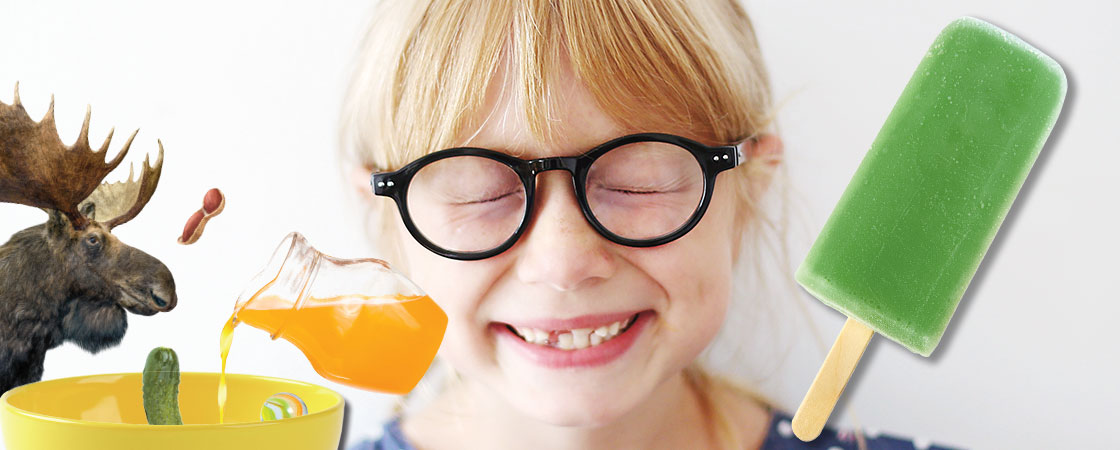If you want to make an ice pop,
first you need a jar of juice,
and a pickle, and a peanut,
and a marble, and a moose.
Then you mix them all together
in whatever bowl you find.
Oh, wait. That’s not the recipe.
I’m sorry. Never mind.

A lighthearted poem about a summertime treat
Learning Objective: Students will examine a poem’s use of figurative language by identifying examples of alliteration.
How to Make an Ice Pop
If you want to make an ice pop,
first you need a jar of juice,
and a pickle, and a peanut,
and a marble, and a moose.
Then you mix them all together
in whatever bowl you find.
Oh, wait. That’s not the recipe.
I’m sorry. Never mind.
Treat your class to another fun poem by Ken Nesbitt! Watch this video of the poet reading his poem “Good Morning, Dear Students,” featuring another unexpected look at a familiar topic!
To learn more about the poet, explore Ken Nesbitt’s Poetry for Kids website. You can find more funny poems, poetry games, and lessons on the site, too!
More About the Article
Content-Area Connections
English Language Arts: figurative language
Essential Question
What makes something we read funny?
Key Skills
figurative language (alliteration), text features, rhyme, text structure, mood, expressing an opinion
1. PREPARING TO READ (10 minutes)
Set a Purpose for Reading
Read aloud the title of the poem and its author’s name, and ask students to predict what the poem might be about.
Preview Text Features and Vocabulary
Point out any vocabulary terms that may be challenging for your students, and ask if anyone knows their definitions. Look up the meanings of the words together, as needed.
Ask students to describe the various images in the illustration.
Direct students’ attention to the green ice pop for information on a text connection within this issue.
2. READING AND DISCUSSING
Next, ask students to take turns reading aloud each line in the poem.
Close-Reading and Critical-Thinking Questions (30 minutes)
3. SEL FOCUS
Celebrating Silliness
Research shows that playfulness is important to our well-being—and can be a great teaching tool. “How to Make an Ice Pop” provides the perfect opportunity to foster creativity while learning about figurative language, all within a playful atmosphere. In pairs or small groups, have your students create original recipes for one of their own favorite treats. Be sure to clarify that the ingredients don’t need to logically make sense! Then have the pairs or small groups share their recipes with the rest of the class. Challenge them to include at least one example of alliteration in their recipes!
4. SKILL BUILDING
Featured Skill: Alliteration
GREAT IDEAS FOR REMOTE LEARNING
Our new Learning Journey Slide Deck (available in your Resources tab) is designed to make your life easier. Have students move through at their own pace or assign smaller chunks for different days. You can also customize the Slide Deck to your liking.
Have students record video or audio of themselves reciting the poem. Invite students to share their recordings with you or, if they would like, with the class.
Before reading the poem, point out to your students that four of the eight lines in this poem rhyme. Ask them to read the last word in each line, and then identify which words rhyme. Then read the poem aloud yourself—or together with your students. Encourage your students to stand up or wave their arms each time they hear or say a rhyming word!
The various components of the poem’s “recipe” may be unfamiliar to some of your ELL students. Read the poem aloud or play the audio version of the poem. Then read the poem aloud a second time, pausing at the end of each line to ask students to explain what each ingredient is. Reinforce the learning by asking students to point to the corresponding picture on the page.
Instruct students to read another humorous poem, “The Spendosaur,” from our December 2018/January 2019 issue. Then ask your students to write a short paragraph comparing and contrasting the two poems.
Have students add two or more lines to the first half of the poem. Their lines should include at least four new ingredients to the ice pop recipe. As an added prompt, challenge your students to include alliteration in their lines. Encourage them to create an illustration for their additional lines!